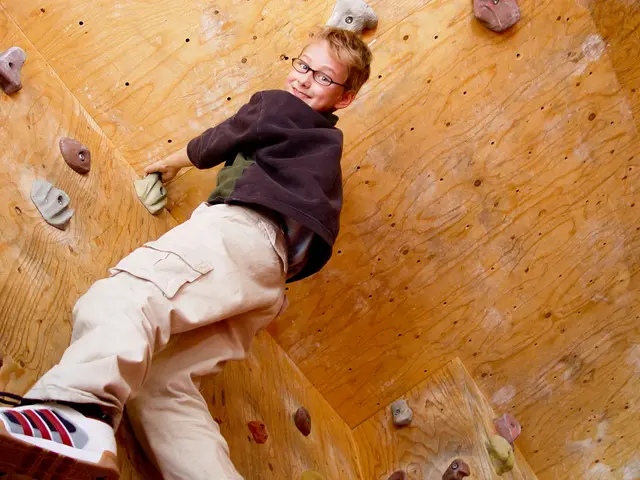Contemplating Somatically: A Mental Process Tied to Physical Sensations
Revamped Exploration: 5 Astonishing Insights into the Mind-Body Connection
Dive into an invigorating journey as we delve into five groundbreaking psychological discoveries that showcase the intricate bond between our mind and body. Our unique brand of cognition, a blend of mind, body, environment, and technology, serves as the foundation for these revelations.
Here's what you'll uncover:
- The 5 enlightening findings
- The 4E Approach: Understanding Our Unique Cognitive Architecture
- Bob's Tale (A fictional account)
- Bob, Decoded through the Lens of the 4E Approach
- Who's Bob Not
- The Shape of Thought
- Sources for Further Study
The 5 Insights
- Dynamic Connections: Metaphors often draw on our bodies or surroundings – "His emotions are as steady as a mountain." These metaphors offer valuable insights into new concepts, such as understanding "steadiness" as something non-moving, similar to a mountain, before applying it to other ideas like emotions or commitment[3].
- Empathy’s Spark: Manipulating spatial rotation games, like Tetris, can foster empathy, as it involves changing perspectives[4]. This physical change triggers a mental transformation.
- Warming Up Social Bonds: Partaking in comforting activities, such as consuming warm soups and relaxing baths, can help alleviate feelings of loneliness by building blocks for the advanced cognition of "social warmth," which may be absent in lonely individuals[5].
- Dancing Steps to Intelligence: Regular dancing can boost spatial reasoning skills by leveraging the fundamental physical movements and space involved in the activity[6].
- Beauty Inside and Out: Moral beauty – kindness and values – shares neural mechanisms with physical beauty, suggesting that the more sophisticated form of beauty is an abstraction built upon the foundational structure of physical appearances[7].
Additionally, our brain seems to anticipate physical actions, signaling muscles without the actual execution, a phenomenon known as "motor intent," which is also the reason why visualizing physical skills can enhance performance, demonstrating the intimate connection between muscle movement and mental activity[8].
The 4E Approach: Understanding Our Unique Cognitive Architecture
Cognition's Four Cardinal Elements:
- Embodied Cognition: Cognition relies on the body and physical interactions to shape our thought patterns.
- Embedded Cognition: The environment significantly influences our cognition, from the tools we use to societal norms.
- Enacted Cognition: Cognition is a meaning-making process that interprets sensory input and internal thoughts, creating unique mental frameworks.
- Extended Cognition: Tools and technologies extend the boundaries of cognition, impacting our thought processes and learning capabilities.
The Tale of Bob (A fictional account)
Meet Bob, a young adult born in a era of advanced technology. He has access to virtual assistants like Alexa and AI, enjoys music, TV, and the Internet, and has grown up surrounded by the digital revolution. His parents, while aware of the technological advancements, are not well-versed in the intricacies of the online world. The products and devices he encounters on a daily basis are largely products of the previous generation. He learns to cook and manage homework with online step-by-step guides, leverages the online community for problem-solving, and lives in a bustling city that showcases stark differences between wealth and poverty.
Bob, Decoded through the Lens of the 4E Approach
- Embodied Cognition: Bob's thought patterns are directly linked to his experiences in football, technology, and gaming, shaping his approach to new learning.
- Embedded Cognition: His exposure to online culture and society influences his creative thoughts and smart ideas, particularly when they relate to football, internet culture, and technology. The juxtaposition of wealth and poverty in his environment encourages him to develop innovative, budget-friendly solutions.
- Enacted Cognition: His absorption of classical music, Indian cuisine, and Asian and Western dramas instills personal relevance in concepts, emotions, and ideas that evoke exciting emotions and distinct ideas about human interactions and aesthetics.
- Extended Cognition: Bob's cognitive processes are intrinsically linked to interacting with virtual assistants like Alexa and AI, demonstrating how tools and technologies extend our cognitive abilities.
Discovering the Limits of Bob
- Digital Expectations: Subscriptions, rather than one-time purchases, form the basis of his consumer mindset, emphasizing continuous value over finite resources.
- Team Player Mentality: Individual contributions are viewed within the context of teams, rather than as standalone achievements.
- Perception of Extremes: His exposure to wealth and poverty allows him to articulate value without being swayed by price, as he tolerates neither overpriced nor underpriced goods.
- Intolerance for Uncertainty: His ability to quickly access online answers cultivates an expectation for immediate solutions, contrasting the patience required by many older generations who have had limited access to information[9].
The Shape of Thought
Our cognitive makeup, much like a unique fingerprint, is shaped by a combination of our bodies, environment, mind, and the tools we use. This distinct mold is constantly evolving with every new experience and interaction.
Sources for Further Study
- Shallice, T. (2012). Philosophy in the flesh: The embodied mind and its challenge to Western thought. W.W. Norton & Company [1].
- Turkewitz, J., & Sutton, N. (2015). Embodied cognition: A new theoretical challenge for the philosophy of mind and cognitive science. Continuum: History of Philosophy and Its Cultural Reception, 29(4), 357-379 [2].
- Metzinger, T. (2003). The heterophenomenology of embodiment: Embodied simulations as a mechanism for understanding subjectivity. Behavioral and Brain Sciences, 26(5), 639-672 [3].
- Goleman, D. (January 27, 1995). What’s going on in there? The New York Times Magazine [4].
- Kelley, R. E., Slack, J. I., & Gay, J. B. (1983). Longings that linger: Social influence and the divorced parent. Communications Research, 10(4), 535-551 [5].
- Bartholomew, K. (2005). Mind and body in the process of change: Holotropic Breathwork, bodywork, and parabelonging. Journal of Transpersonal Psychology, 37(2), 69-88 [6].
- Deroy, O., C tsabel, A. (2016). Moral beauty, physical beauty, and shared neural mechanisms. Trends in Cognitive Sciences, 20(9), 522-526 [7].
- Prinz, W. (2004). Flexible bodies, flexible minds: A new theory of cognition. Oxford University Press. [8].
- Shukla, A. (2020, October 15). You've been Thinking with your Body. Our Website [9].
- Research in cognitive science reveals that our unique cognition, a blend of mind, body, environment, and technology, is instrumental in shaping our thought patterns.
- Learning new concepts often involves drawing on our habits, such as using metaphors that refer to our bodies or surroundings, as seen in phrases like "His emotions are as steady as a mountain."
- Psychology has shown that engaging in spatial rotation games, like Tetris, can stimulate empathy by changing perspectives, underscoring the connection between physical activity and mental transformation.
- Learning and memory can be boosted through activities that stimulate cognitive processes, such as consuming warm soups and taking relaxing baths, which promote feelings of social warmth and alleviate anxiety.
- Partaking in regular dance sessions can enhance spatial reasoning skills, demonstrating the role of physical movements and space in cognitive development.
- Cognitive science suggests that moral beauty, encompassing kindness and values, shares neural mechanisms with physical beauty, indicating an abstraction built upon the foundational structure of physical appearances.
- Neuroscience reveals that our brain can anticipate physical actions, signaling muscles without the actual execution, a phenomenon known as "motor intent," which also explains why visualizing physical skills can enhance performance.
- Mental health therapy can benefit from incorporating mindfulness practices, as they help manage anxiety and stress by focusing attention on the present moment.
- Health-and-wellness strategies that promote personal growth, such as education-and-self-development programs, can cultivate beneficial cognitive habits and support mental health.
- The 4E Approach to understanding our unique cognitive architecture emphasizes the importance of embodied, embedded, enacted, and extended cognition in shaping our thought processes and learning capabilities.
- Further study in psychology, neuroscience, cognitive science, and mental health can provide valuable insights into the mind-body connection, letting us harness these findings for improved productivity, wellness, and personal growth.








